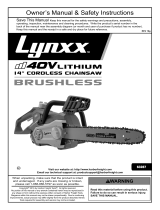
wrenchorakeyleftattachedtothepower
toolmayresultinpersonalinjury.
E.Donotoverreach.Keepproper
footingandbalanceatalltimes.This
enablesbettercontrolofthepowertoolin
unexpectedsituations.
F.Dressproperly.Donotwearloose
clothingorjewelry.Keepyourhair,
clothing,andglovesawayfrommoving
parts.Looseclothes,jewelry,orlonghair
cangetcaughtinmovingparts.
G.Ifdevicesareprovidedforthedust
extractionandcollection,ensurethat
theseareconnectedandproperly
used.Usingthesedevicescanreduce
dust-relatedhazards.
H.Keepyourhandsandfeetawayfromthe
cuttingarea.
3.Powertooluseandcare
A.Donotforcethepowertool.Usethe
correctpowertoolforyourapplication.
Thecorrectpowertoolwilldothejob
betterandsaferattherateforwhichitwas
designed.
B.Donotusethepowertooliftheswitch
doesnotturnitonandoff.Anypowertool
thatcannotbecontrolledwiththeswitchis
dangerousandmustberepaired.
C.Disconnecttheplugfromthepower
sourceand/orthebatterypackfromthe
powertoolbeforeadjustingit,changing
accessoriesonit,orstoringit.Such
preventivesafetymeasuresreducetherisk
ofstartingthepowertoolaccidentally.
D.Storeidlepowertoolsoutofthereach
ofchildren,anddonotallowpersons
unfamiliarwiththepowertoolorthese
instructionstooperatethepowertool.
Powertoolsaredangerousinthehandsof
untrainedusers.
E.Storeidleappliancesindoors.Whennot
inuse,appliancesshouldbestoredindoors
inadryandhighorlocked-upplace,outof
thereachofchildren.
F.Maintainpowertools.Checkfor
misalignmentorbindingofmoving
parts,brokenparts,andanyother
conditionthatmayaffecttheoperation
ofthepowertools.Ifdamaged,havethe
powertoolrepairedbeforeuse.Many
accidentsarecausedbypoorlymaintained
powertools.
G.Keepcuttingtoolssharpandclean.
Properlymaintainedcuttingtoolswithsharp
cuttingedgesarelesslikelytobindandare
easiertocontrol.
H.Usethepowertool,accessories,
toolbits,etc.inaccordancewith
theseinstructionsandinthemanner
intendedfortheparticulartypeofpower
tool,takingintoaccounttheworking
conditionsandtheworktobeperformed.
Usingthepowertoolforoperationsdifferent
fromthoseintendedcouldresultina
hazardoussituation.
I.Keepguardsinplaceandinworking
order.
J.Useonlyreplacementguidebarsand
chainsspeciedbythemanufacturer.
Incorrectreplacementguidebarsand
chainsmaycausechainbreakageand/or
kickback.
K.Followthemanufacturer’ssharpening
andmaintenanceinstructionsforthe
sawchain.Decreasingthedepthgauge
heightcanleadtoincreasedkickback.
4.ChainSawSafety
A.Holdthepowertoolbyinsulatedgripping
surfacesonly,becausethesawchain
maycontacthiddenwiringoritsown
cord.Sawchainscontactingalivewiremay
makeexposedmetalpartsofthepowertool
liveandcouldgiveyouanelectricshock.
B.Wearsafetyglasses,hearingprotection,
andprotectiveequipmentforyourhead,
hands,legs,andfeet.Wearingadequate
protectiveclothingreducespersonalinjury
byyingdebrisoraccidentalcontactwith
thesawchain.
C.Cuttingtreescanbehazardousand
requiresexpertise.Donotusethechain
sawtofelllargetreesthathaveadiameter
greaterthanthelengthoftheguidebar.
D.Donotoperateachainsawinatree.
Operatingachainsawwhileupinatree
mayresultinpersonalinjury.
E.Alwayskeepproperfootingandoperate
thechainsawonlywhenstandingona
xed,secure,andlevelsurface.Slippery
orunstablesurfacessuchasladdersmay
causealossofbalanceorcontrolofthe
chainsaw.
F.Whencuttingalimbthatisunder
tension,bealertforspringback.When
thetensioninthewoodberisreleased,the
springloadedlimbmaystrikeyouand/or
throwthechainsawoutofcontrol.
3






















